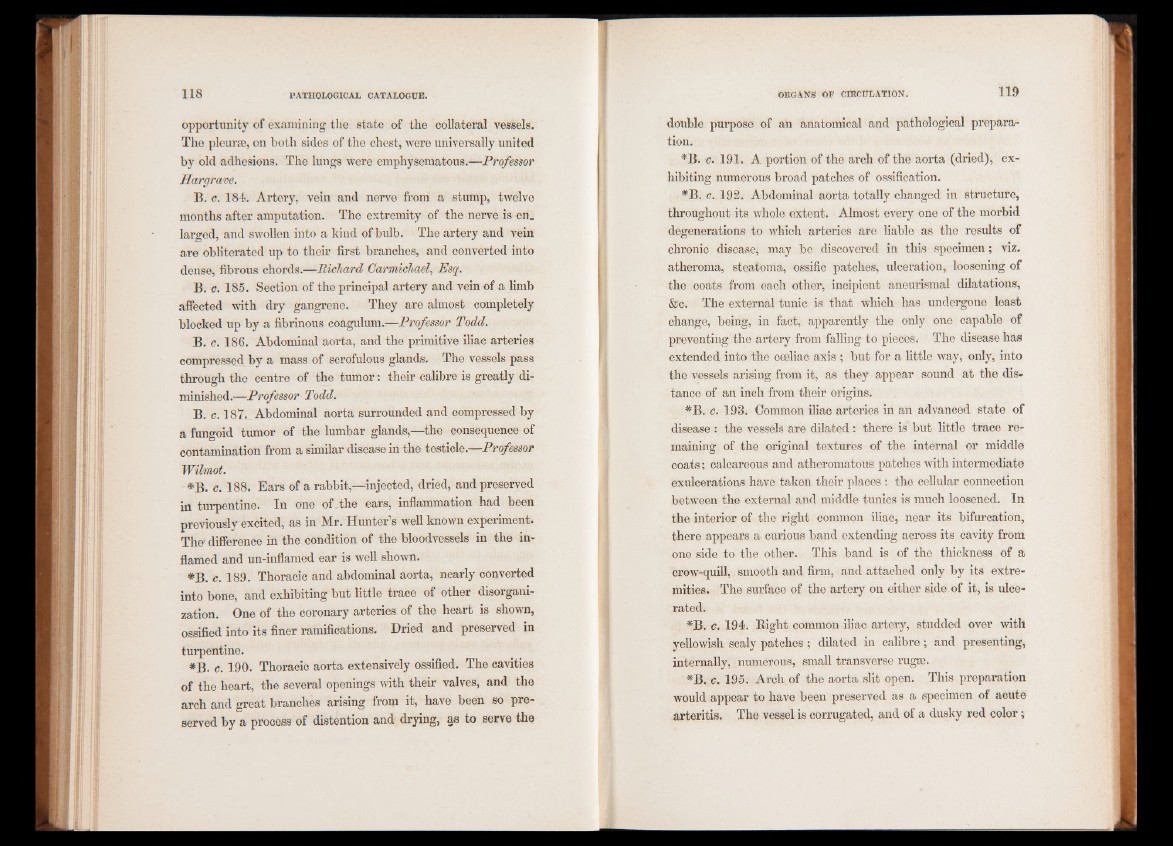
opportunity of examining the state of the collateral vessels.
The pleurae, on both sides of the chest, were universally united
by old adhesions. The lungs were emphysematous.—Professor
Hargrave.
B. c. 184. Artery, vein and nerve from a stump, twelve
months after amputation. The extremity of the nerve is en_
larged, and swollen into a kind of bulb. The artery and vein
are obliterated up to their first branches, and converted into
dense, fibrous chords.—Richard Carmichael, Esq.
B. c. 185. Section of the principal artery and vein of a limb
affected with dry gangrene. They are almost completely
blocked up by a fibrinous coagulum.—Professor Todd.
B. c. 186. Abdominal aorta, and the primitive iliac arteries
compressed by a mass of scrofulous glands. The vessels pass
through the centre of the tumor: their calibre is greatly diminished.—
Professor Todd.
B. c. 187. Abdominal aorta surrounded and compressed by
a fungoid tumor of the lumbar glands,—the consequence of
contamination from a similar disease in the testicle.—Professor
Wilmot.
*B. c. 188. Ears of a rabbit,—injected, dried, and preserved
in turpentine. In one of the ears, inflammation had been
previously excited, as in Mr. Hunter’s well known experiment.
The difference in the condition of the bloodvessels in the inflamed
and un-inflamed ear is well shown.
*B. c. 189. Thoracic and abdominal aorta, nearly converted
into bone, and exhibiting but little trace of other disorganization.
One of the coronary arteries of the heart is shown,
ossified into its finer ramifications. Dried and preserved in
turpentine.
#B. c. 190. Thoracic aorta extensively ossified. The cavities
of the heart, the several openings with their valves, and the
arch and great branches arising from it, have been so preserved
by a process of distention and drying, as to serve the
double purpose of an anatomical and pathological preparation.
*B. c. 191. A portion of the arch of the aorta (dried), exhibiting
numerous broad patches of ossification.
#B. c. 192. Abdominal aorta totally changed in structure,
throughout its whole extent. Almost every one of the morbid
degenerations to which arteries are liable as the results of
chronic disease, may be discovered in this specimen; viz.
atheroma, steatoma, ossific patches, ulceration, loosening of
the coats from each other, incipient aneurismal dilatations,
&c. The external tunic is that which has undergone least
change, being, in fact, apparently the only one capable of
preventing the artery from falling to pieces^ The disease has
extended into the coeliac axis ; but for a little way, only, into
the vessels arising from it, as they appear sound at the distance
of an inch from their origins.
#B. c. 193. Common iliac arteries in an advanced state of
disease : the vessels are dilated: there is but little trace remaining
of the original textures of the internal or middle
coats; calcareous and atheromatous patches with intermediate
exulcerations have taken their places : the cellular connection
between the external and middle tunics is much loosened. In
the interior of the right common iliac, near its bifurcation,
there appears a curious band extending across its cavity from
one side to the other. This band is of the thickness of a
crow-quill, smooth and firm, and attached only by its extremities.
The surface of the artery on either side of it, is ulcerated.
*B. c. 194. Right common iliac artery, studded over with
yellowish scaly patches; dilated in calibre; and presenting,
internally, numerous, small transverse rugae.
*B. c. 195. Arch of the aorta slit open. This preparation
would appear to have been preserved as a specimen of acute
arteritis. The vessel is corrugated, and of a dusky red color;